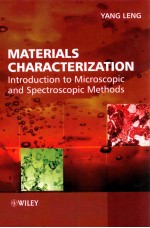

Materials Characterization:Introduction to Microscopic and Spectroscopic MethodsPDF电子书下载
- 电子书积分:12 积分如何计算积分?
- 作 者:Leng
- 出 版 社:Limited
- 出版年份:2008
- ISBN:
- 页数:338 页
1 Light Microscopy 1
1.1 Optical Principles 1
1.1.1 Image Formation 1
1.1.2 Resolution 3
1.1.3 Depth of Field 5
1.1.4 Aberrations 6
1.2 Instrumentation 8
1.2.1 Illumination System 9
1.2.2 Objective Lens and Eyepiece 13
1.3 Specimen Preparation 15
1.3.1 Sectioning 15
1.3.2 Mounting 16
1.3.3 Grinding and Polishing 19
1.3.4 Etching 22
1.4 Imaging Modes 25
1.4.1 Bright-Field and Dark-Field Imaging 25
1.4.2 Phase Contrast Microscopy 26
1.4.3 Polarized Light Microscopy 30
1.4.4 Nomarski Microscopy 34
1.4.5 Fluorescence Microscopy 37
1.5 Confocal Microscopy 38
1.5.1 Working Principles 39
1.5.2 Three-Dimensional Images 41
References 43
Questions 43
2 X-ray Diffraction Methods 45
2.1 X-ray Radiation 45
2.1.1 Generation of X-rays 45
2.1.2 X-ray Absorption 48
2.2 Theoretical Background of Diffraction 49
2.2.1 Diffraction Geometry 49
2.2.2 Diffraction Intensity 56
2.3 X-ray Diffractometry 58
2.3.1 Instrumentation 59
2.3.2 Samples and Data Acquisition 61
2.3.3 Distortions of Diffraction Spectra 64
2.3.4 Applications 66
2.4 Wide Angle X-ray Diffraction and Scattering 71
2.4.1 Wide Angle Diffraction 71
2.4.2 Wide Angle Scattering 74
References 76
Questions 76
3 Transmission Electron Microscopy 79
3.1 Instrumentation 79
3.1.1 Electron Sources 81
3.1.2 Electromagnetic Lenses 83
3.1.3 Specimen Stage 85
3.2 Specimen Preparation 86
3.2.1 Pre-Thinning 86
3.2.2 Final Thinning 87
3.3 Image Modes 89
3.3.1 Mass-Density Contrast 90
3.3.2 Diffraction Contrast 92
3.3.3 Phase Contrast 96
3.4 Selected Area Diffraction 101
3.4.1 Selected Area Diffraction Characteristics 101
3.4.2 Single-Crystal Diffraction 103
3.4.3 Multi-Crystal Diffraction 108
3.4.4 Kikuchi Lines 108
3.5 Images of Crystal Defects 111
3.5.1 Wedge Fringe 111
3.5.2 Bending Contours 113
3.5.3 Dislocations 115
References 118
Questions 118
4 Scanning Electron Microscopy 121
4.1 Instrumentation 121
4.1.1 Optical Arrangement 121
4.1.2 Signal Detection 123
4.1.3 Probe Size and Current 124
4.2 Contrast Formation 129
4.2.1 Electron-Specimen Interactions 129
4.2.2 Topographic Contrast 130
4.2.3 Compositional Contrast 133
4.3 Operational Variables 134
4.3.1 Working Distance and Aperture Size 134
4.3.2 Acceleration Voltage and Probe Current 137
4.3.3 Astigmatism 138
4.4 Specimen Preparation 138
4.4.1 Preparation for Topographic Examination 139
4.4.2 Preparation for Micro-Composition Examination 142
4.4.3 Dehydration 142
References 143
Questions 144
5 Scanning Probe Microscopy 145
5.1 Instrumentation 145
5.1.1 Probe and Scanner 147
5.1.2 Control and Vibration Isolation 148
5.2 Scanning Tunneling Microscopy 148
5.2.1 Tunneling Current 148
5.2.2 Probe Tips and Working Environments 149
5.2.3 Operational Modes 149
5.2.4 Typical Applications 150
5.3 Atomic Force Microscopy 152
5.3.1 Near-Field Forces 152
5.3.2 Force Sensors 154
5.3.3 Operational Modes 155
5.3.4 Typical Applications 161
5.4 Image Artifacts 165
5.4.1 Tip 165
5.4.2 Scanner 167
5.4.3 Vibration and Operation 168
References 169
Questions 169
6 X-ray Spectroscopy for Elemental Analysis 171
6.1 Features of Characteristic X-rays 171
6.1.1 Types of Characteristic X-rays 173
6.1.2 Comparison of K,L and M Series 175
6.2 X-ray Fluorescence Spectrometry 176
6.2.1 Wavelength Dispersive Spectroscopy 179
6.2.2 Energy Dispersive Spectroscopy 183
6.3 Energy Dispersive Spectroscopy in Electron Microscopes 186
6.3.1 Special Features 186
6.3.2 Scanning Modes 187
6.4 Qualitative and Quantitative Analysis 189
6.4.1 Qualitative Analysis 189
6.4.2 Quantitative Analysis 191
References 195
Questions 195
7 Electron Spectroscopy for Surface Analysis 197
7.1 Basic Principles 197
7.1.1 X-ray Photoelectron Spectroscopy 197
7.1.2 Auger Electron Spectroscopy 198
7.2 Instrumentation 201
7.2.1 Ultra-High Vacuum System 201
7.2.2 Source Guns 202
7.2.3 Electron Energy Analyzers 204
7.3 Characteristics of Electron Spectra 206
7.3.1 Photoelectron Spectra 206
7.3.2 Auger Electron Spectra 208
7.4 Qualitative and Quantitative Analysis 209
7.4.1 Qualitative Analysis 209
7.4.2 Quantitative Analysis 219
7.4.3 Composition Depth Profiling 221
References 222
Questions 223
8 Secondary Ion Mass Spectrometry for Surface Analysis 225
8.1 Basic Principles 226
8.1.1 Secondary Ion Generation 226
8.1.2 Dynamic and Static SIMS 229
8.2 Instrumentation 230
8.2.1 Primary Ion System 230
8.2.2 Mass Analysis System 234
8.3 Surface Structure Analysis 237
8.3.1 Experimental Aspects 238
8.3.2 Spectrum Interpretation 239
8.4 SIMS Imaging 244
8.4.1 Generation of SIMS Images 244
8.4.2 Image Quality 245
8.5 SIMS Depth Profiling 245
8.5.1 Generation of Depth Profiles 246
8.5.2 Optimization of Depth Profiling 246
References 250
Questions 250
9 Vibrational Spectroscopy for Molecular Analysis 253
9.1 Theoretical Background 253
9.1.1 Electromagnetic Radiation 253
9.1.2 Origin of Molecular Vibrations 255
9.1.3 Principles of Vibrational Spectroscopy 257
9.1.4 Normal Mode of Molecular Vibrations 259
9.1.5 Infrared and Raman Activity 261
9.2 Fourier Transform Infrared Spectroscopy 267
9.2.1 Working Principles 267
9.2.2 Instrumentation 269
9.2.3 Fourier Transform Infrared Spectra 271
9.2.4 Examination Techniques 273
9.2.5 Fourier Transform Infrared Microspectroscopy 276
9.3 Raman Microscopy 279
9.3.1 Instrumentation 280
9.3.2 Fluorescence Problem 283
9.3.3 Raman Imaging 284
9.3.4 Applications 285
9.4 Interpretation of Vibrational Spectra 290
9.4.1 Qualitative Methods 290
9.4.2 Quantitative Methods 297
References 299
Questions 300
10 Thermal Analysis 301
10.1 Common Characteristics 301
10.1.1 Thermal Events 301
10.1.2 Instrumentation 303
10.1.3 Experimental Parameters 303
10.2 Differential Thermal Analysis and Differential Scanning Calorimetry 305
10.2.1 Working Principles 305
10.2.2 Experimental Aspects 309
10.2.3 Measurement of Temperature and Enthalpy Change 312
10.2.4 Applications 315
10.3 Thermogravimetry 319
10.3.1 Instrumentation 321
10.3.2 Experimental Aspects 322
10.3.3 Interpretation of Thermogravimetric Curves 326
10.3.4 Applications 328
References 331
Questions 331
Index 333
- 《发展中国家畜牧生产系统中进口精饲料代用品专家磋商会议论文集》R.Sansoucy T.R.Preston R.A.Leng编 1990
- 《Materials Characterization:Introduction to Microscopic and Spectroscopic Methods》Leng 2008
- 《Corporate governance and financial reform in China's transition economy》Jing Leng. 2009
- 《Isotopes in palaeoenvironmental research》edited by Melanie J. Leng 2006
- 《MATERILS CHARACTERIZATION INTRODUCTION TO MICOSCOPIC AND SPECTROSCOPIC METHODS SECOND EDITION》YANG LENG 2013
- 《Shape-Memory Polymers and Multifunctional Composites》Jinsong Leng 2010
- 《遗传学基础》沈大Leng编 1988
- 《商品学概论》万 融,张万福,吴小Leng编著 1981
- 《汉语流行口语 最新版 latest edition》李杰群等编著;Jian Leng(冷健)等翻译 2007
